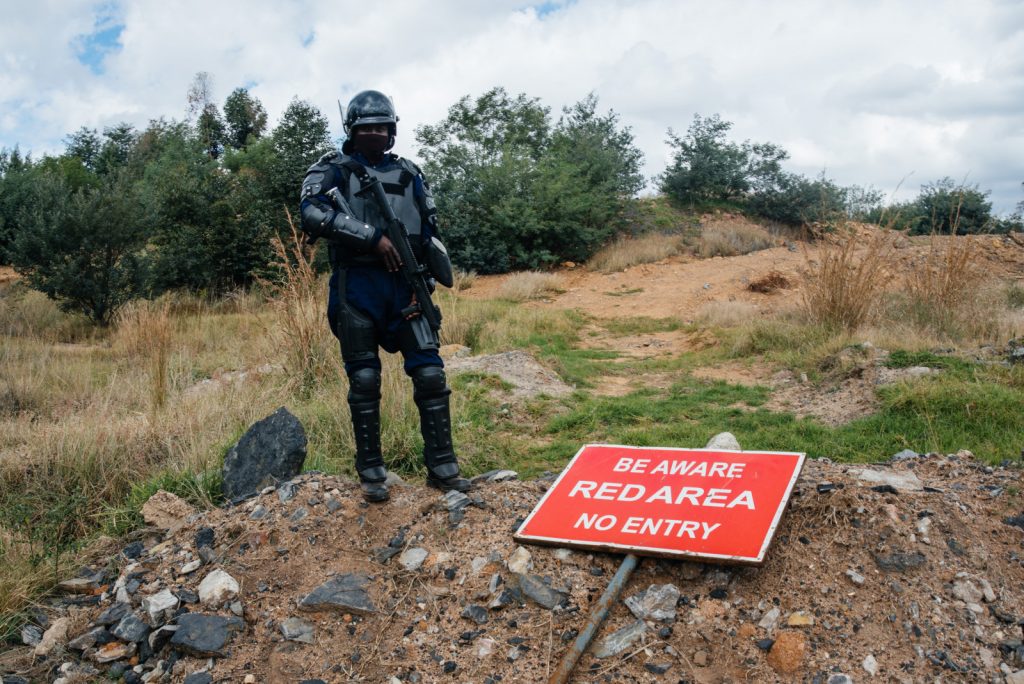More than 20 years ago, Carol Wade packed up her life in Johannesburg and moved to the scenic heart of the Zusterstroom Valley in Bronkhorstspruit.
Life here has been idyllic: fresh, clean mountain water, pristine bushveld and a tight-knit community of lodge owners and farmers who rely on the largely natural Wilge River to sustain their livelihoods. “The river is our lifeblood, the source of our existence,” she said.
But on 14 February, disaster struck. A single brick-lined concrete seal at the south shaft of the old Kromdraai coal mine upstream failed, decanting millions of litres of toxic acid mine drainage (AMD) into the river system. The mine, which was last operational in 1966, is part of Thungela Resources’ Khwezela Colliery, outside eMalahleni.
The acidic water flowed uncontrolled into the Kromdraaispruit, poured into the Saalboomspruit, gushed into the Wilge River, which leads into the Olifants River, until it reached the inlet to Loskop Dam. Within days, tonnes of fish were wiped out in what has been compared to a “chemical burn”.
Acid mine drainage, which has a low pH and is high in acidity, occurs when water reacts with pyrite in mining cavities beneath the earth’s surface. It is rich in iron, lead and other metals, many of which are present in toxic concentrations and also contains high concentrations of sulphate.
The pollution plume travelled through the mountains before it reached Meulstroom Lodge, on the banks of the river, where it was spotted. Here, the river was observed to be yellow-orange, blue — probably from the precipitation of aluminium compounds — and red.
“There were big fish lying dead and dying all over,” grimaced Wade, the river’s rapids roaring around her as she spoke to Mail & Guardian. “They were gasping at the surface. There wasn’t even a dragonfly, nothing. It was horrible. And there was this sulphuric, acid stench from the river.”
Criminal probe
The spill was “catastrophic”, said Francois Roux, an aquatic scientist at the Mpumalanga Tourism and Parks Agency (MTPA). It covered 95km of the river system and obliterated all aquatic life because of the extremely low pH values and metal toxicity of the acid water.
In total, 26 different fish species, most indigenous, in the different river reaches were affected, resulting in their extinction in these waterways. Some are listed in the International Union for Conservation of Nature (IUCN) red list as being threatened at a global level.
Now, the department of water and sanitation and the department of forestry, fisheries and the environment have launched a criminal investigation.
Water and sanitation spokesperson Sputnik Ratau said the aim is to gather evidence to lay criminal charges against the mine. This will ensure that the polluter is held criminally liable for the actions that caused damage to water resources and the environment, that the “polluter pays” for the effect of pollution on water resources and the environment and that “the polluter is held accountable for their actions”.
Green Scorpions
Albi Modise, forestry, fisheries and environment spokesperson, said the Green Scorpions are working closely with water and sanitation officials in pursuing a criminal investigation. A criminal case was registered at the Vosman police station.
“The extent and cause of the spillage, which resulted in serious harm to the environment, forms the main focus of the investigation as various offences in the environmental legislation relate to unlawful and intentional or negligent acts, which cause significant harm to the environment and/or detrimentally affect the environment,” said Modise.
The mine tailing dam at Thungela Colliery near the source of the Kromdraai River where the acid mine drainage spill occurred. The pump pictured is being used to divert polluted water from the spill in the Kromdraai River back into the tailing dam. Photograph: James Puttick.
Evidence from the investigation will be presented and a decision will be made by the National Prosecuting Authority whether to pursue a prosecution.
The spill is the largest and most severe in the country and will be regarded as a test case for river pollution and the rehabilitation of rivers, Roux said. “If Thungela is not prosecuted and held accountable for this AMD spill, the message to the coal mining industry and other polluters would reflect poorly.”
Searching for signs of life
Large volumes of water were released from the Bronkhorstspruit and Witbank dams to flush the pollution. According to Thungela, independent water analysis has shown water quality has “normalised to the baseline quality” before the spill.
“But where are the fish?” asked Wade, as she scanned the river for signs of life. “Before, we had kingfishers and fish eagles here. I don’t see them anymore because there’s nothing for them to eat …. I still don’t see life as it was. If you see what we had, you can’t put a price on that. I’m gutted at what we’ve lost.”
Cara Stokes, chairperson of the Bronkhorspruit Catchment Management Forum, pointed out pockets of AMD lurking at the river’s edge.
These are critical nurseries for aquatic species, but here it appears little life remains. “We don’t even know how long it will take for the habitat to be restored, because we’ve never had a full kill of a river for 100km where almost everything was obliterated,” she told the M&G.
Thungela has received three claims from landowners for road damage, crop losses and for 12 livestock deaths.
Chairperson of the Bronkhorstspruit Catchment Management Forum, Cara Stokes (left), and local landowner Carol Wade (right) on the banks of the Wilge River, which was heavily impacted by the acid mine drainage spill that originated at the Thungela Colliery near eMalahleni in Mpumalanga. Photograph: James Puttick.
‘Dead’ river
“The bottom line is that we’re 17 weeks down the drain and what have they (Thungela) done in terms of the environment and the rehabilitation of the river?” Roux asked.
“Nothing, other than conducting water quality monitoring. I’m quite sure they’ve done a lot on the mine to stop the pollution, but what about the river that’s dead now?”
He recently wrote to Thungela’s chief executive, July Ndlovu, outlining the MTPA’s concerns, but has yet to receive a response. Although Thungela has appointed a service provider, the Biodiversity Company, to develop and implement its rehabilitation plan, Roux maintained it is a compliance monitoring company.
“Rehabilitation and restoration of an aquatic ecosystem is a specialist field. We have to get the river back to what it was prior to the spill ….We need to determine the current ecostatus of the river. Today, I can release 100 000 fish of different species in there but if the water quality and the habitat is not right, they’re not going to survive.”
Detailed plans
Mpumi Sithole, Thungela’s executive head of corporate affairs, said the company had submitted a high-level rehabilitation plan to the water and sanitation department for its consideration and input. Ratau said the department was monitoring the plan.
“We have also developed a detailed proposed plan and set aside resources for implementation,” said Sithole.
Mining trucks and diggers at the Thungela Colliery near eMalahleni in Mpumalanga. Photograph: James Puttick.
“The first phase of the rehabilitation plan entails conducting an ecosystem assessment and this work has commenced. We will be commencing with public participation with affected and interested stakeholders … to obtain input into the proposed rehabilitation plan.”
The MTPA had not seen the plan, Roux said. “Surely the MTPA, with the conservation mandate in the province, should be consulted as a stakeholder?”
According to Sithole, the Biodiversity Company will work with Thungela’s internal specialists and will collaborate with the University of Mpumalanga, which has done work in the river system. “We envisage that we will also work with the MTPA as a technical partner given their technical expertise pertaining to the reintroduction of the fish species to the river system.”
No quick fix
The restoration will take many years and “there is no quick fix solution”, Roux said. He pointed out how the water and sanitation department had to issue a directive “to force [Thungela] to do something but for three, four days this AMD was leaching uncontrolled until they got a directive and then only did they do it”.
A crocodile has since died at the Loskop Dam nature reserve, but the MTPA couldn’t take samples. The mine promised to provide four satellite collars to monitor the crocodiles’ movement patterns but, to date, none have been received.
Sithole said Thungela has “commenced procurement processes” to source them.
ivestock graze on the banks of the Kromdraai River just downstream of where a large acid mine drainage spill occurred from the Thungela Colliery near eMalahleni in Mpumalanga. The spill originated at the source of the Kromdraai River and flowed into the Saalboom- and then the Wilge Rivers before entering Loskop Dam, killing most aquatic life over approximately 100km downstream. Photograph: James Puttick.
Illegal mining
The physical rehabilitation at the Kromdraai site continues and designs for long-term interventions are under way, Sithole said. Ramp seven, near the south shaft where the seal broke, is connected to the previously mined underground workings and one of the areas affected by illegal mining. “With the significant amounts of rain experienced at the beginning of the year, the illegal miners pumped water to ramp seven to enable their illegal activities.
“Over time, water seeped from ramp seven to the underground workings, increasing the levels of water within the workings. In addition, in Kromdraai, we have experienced severe theft and vandalism of critical water management infrastructure, which destroyed the water management system,” said Sithole.
For Roux, the blame can’t be pinned on illegal mining. “Thungela is responsible for the closing of the mine and the immediate mine area.”





